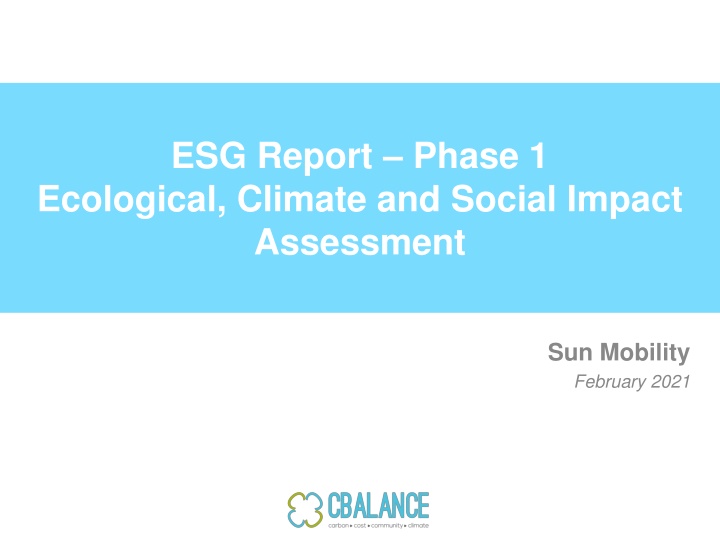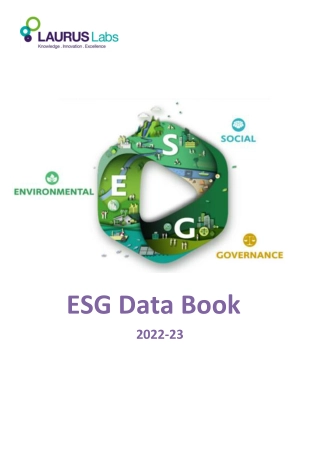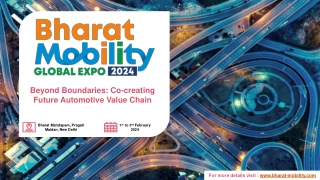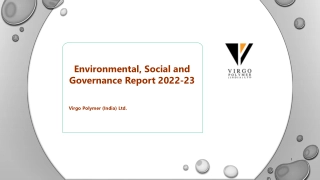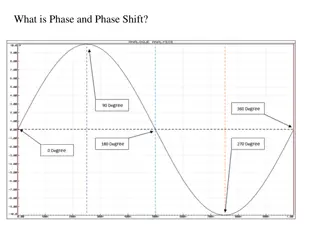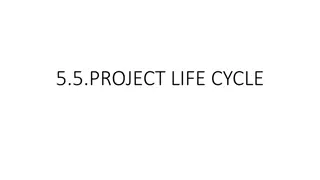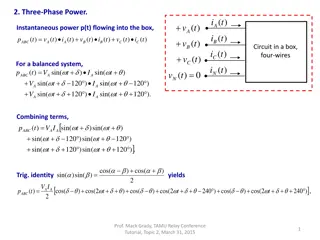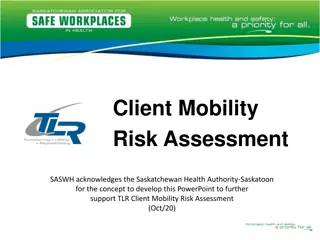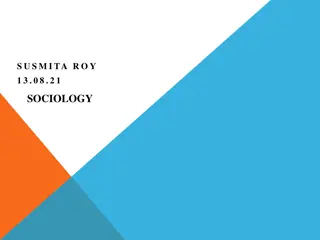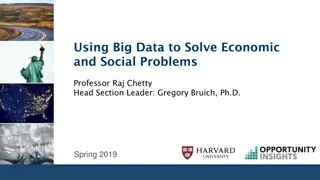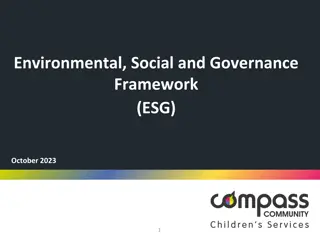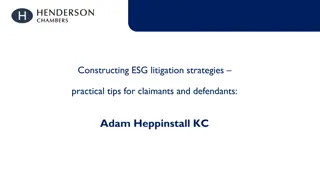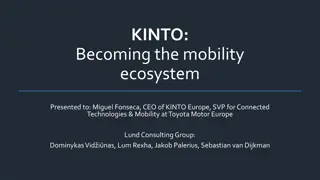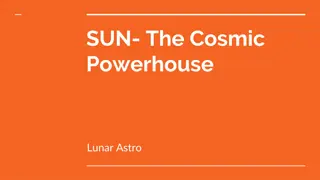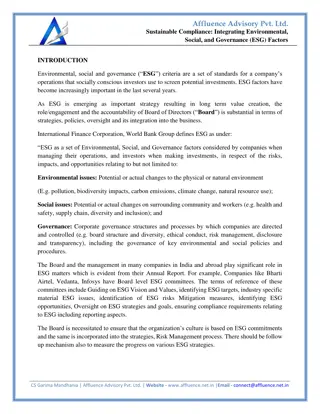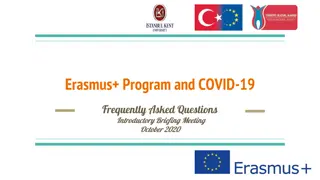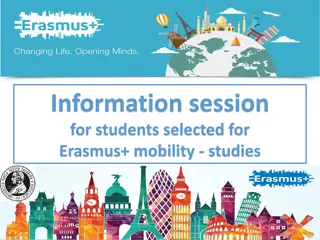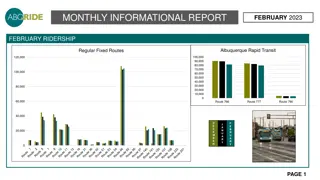Sun Mobility ESG Report Phase 1 - Impact Assessment February 2021
This report delves into the ecological, climate, and social impact assessment of Sun Mobility, focusing on life-cycle inventory analysis, assumptions made, and the goals and scope of the study. It aims to establish baseline life cycle footprints for conventional vehicles and Battery-as-a-Service solutions, providing technical support for a science-based relationship with customers and investors.
Download Presentation

Please find below an Image/Link to download the presentation.
The content on the website is provided AS IS for your information and personal use only. It may not be sold, licensed, or shared on other websites without obtaining consent from the author.If you encounter any issues during the download, it is possible that the publisher has removed the file from their server.
You are allowed to download the files provided on this website for personal or commercial use, subject to the condition that they are used lawfully. All files are the property of their respective owners.
The content on the website is provided AS IS for your information and personal use only. It may not be sold, licensed, or shared on other websites without obtaining consent from the author.
E N D
Presentation Transcript
ESG Report Phase 1 Ecological, Climate and Social Impact Assessment Sun Mobility February 2021
Process Flow 4. Life-Cycle Inventory Analysis & Interpretation 3. Life Cycle Inventory Compilation 2. Life-Cycle Inventory Data Collection 1. Project Goals and Scope Definition 2
Assumptions Assumptions In-Use and not rated Fuel Efficiency of Electric Vehicles (EVs) and Internal Combustion Engine Vehicles (ICEs) used; based on data supplied by Fleet Operators. Renewable Energy contribution to electricity fuel-mix accounted for in deriving Use- Phase GHG Emissions. Material Acquisition and Pre-processing (including mining of rare earth metals, Lithium etc.) were not considered in this Phase and will be integrated in Phase 2 of the assessment process. Emissions from mining, transporting, and distributions of fossil fuels (for ICEs and for non-renewable component of grid electricity were estimated and included in this Phase. Emissions from Battery Production, End of Life processes for Vehicle Body (i.e. recycling, disposal etc. of metal, polymers, glass etc.), and Battery-Recycling were not considered in this Phase and will be integrated in Phase 2 of the assessment process. Emissions from Distribution and Storage stage were considered to be negligible compared to other LCA stages and hence not included. 3
Goal & Scope Definition Goal Establishing baseline life cycle carbon and air pollutant footprints for conventional (ICE), Lead-Acid EVs. Conducting a comparative analysis, based on primary as well as secondary research, with the life cycle footprint of Sun Mobility s Swappable Lithium-Ion Battery solutions (Battery-as-a-Service, Baas) for Electric Vehicle. Provide high-caliber technical support for establishing a science-based voluntary self-disclosure centric financial and communications relationship with its customers and potential/current investors, through the results and insights derived from the comparative Life-Cycle-Analysis study of Sun Mobility's EV-mobility enabling products relative to Business-as-Usual mobility solutions prevalent in India in 2020. 4
Goal & Scope Definition Scope Conduct comparative life cycle footprint analysis between EV and ICE Vehicles according to the life-cycle boundary defined below and analyze them through per vehicle-km travel scenario models. Life Cycle Stage Sub-Stage Included within Boundary Ore and other raw material mining and extraction No Material Acquisition and Pre- Processing Metal and other material processing No Fuel Supply Chain (Mining, Extraction, Transport, Power Generation) Metal and other material procurement Yes No Production Transformation of metals and other materials No Assembling No Domestic Transport for Export No Distribution and Storage International Transport for Export No Use Vehicle Use & Ride Scenarios Yes End-of-Life Disposal of Batteries No 5
Goal & Scope Definition Scope 1. PART 1: Primary Fuel Efficiency & Vehicle Research and Data Collection: Conducting primary and secondary research through literature reviews, interviews with stakeholders, web research catalogues to collate information on vehicle make, model, design and efficiency along with manufacturing and other details. 2. PART 2: Formulating Vehicle based Emission Factors: Thorough and comprehensive formulizing of vehicle-based emissions factors 3. PART 3: Conducting Life Cycle Assessments: Designing Spreadsheet models to calculate GHG and Non-Particulate Air Pollution mitigation assessments of Business-As-Usual and Intervention scenarios in accordance with the WRI GHG Protocol s Product Life Cycle Accounting and Reporting Standard and the Scope 3 Emissions Accounting and Reporting Standard. 6
Goal & Scope Definition Scope 4. PART 4: Estimating Particulate Carbon (Black Carbon) Emissions and local air quality impacts in congruence with the Black Carbon Methodology for the Logistics Sector (2017) developed by the Global Green Freight Project s Smart Freight Centre. 5. PART 5: Estimating the economic wellbeing benefits for materially relevant subsets of stakeholders/end-users of products in accordance with specific indicators and methodologies articulated in the Global Reporting Initiative s G4 Sustainability Reporting Guidelines relevant sections related to Economic Performance (G4 EC1 and EC4). 7
Protocols & Standards International Protocols followed: 1996 & 2006 IPCC Guidelines for National Greenhouse Gas Inventories, Vol. 2 Energy for developing Scope 2 & Scope 3 Emission Factors for Indian Grid Electricity Mix. EMEP/EEA Air Pollutant Emission Inventory Guidelines. Greenhouse Gas Protocol s Product Life Cycle Accounting and Reporting Standard (WRI, WBCSD). Global Reporting Initiative s G4 Sustainability Reporting Guidelines. Black Carbon Methodology for the Logistics Sector (2017), Global Green Freight Project. 8
Table 1 GHG Mitigation Table 1: Greenhouse Gas Mitigation upto 2025 (BAU Renewables % in Grid) 2022 2023 2024 2025 (tonnes CO2e)(tonnes Vehicle Type (tonnes CO2e) (tonnes CO2e) Sr. No. CO2e) 1 Bus (Heavy Duty) - India - - - - 2 Bus (Heavy Duty) - World 2,872 29,519 105,649 248,656 3 Scooter - India 1,169 8,248 22,557 49,632 4 Scooter - World 24,380 98,418 225,039 455,147 5 Three Wheeler (Freight) - India 5,234 19,607 80,242 160,516 6 Three Wheeler (Freight) - World - - - - 7 Three Wheeler (Passenger) - India 2,595 23,694 102,720 158,658 8 Three Wheeler (Passenger) - World 17,853 58,292 121,937 225,773 9 Truck (Light Duty) - India - 4,559 47,703 129,877 10 Truck (Light Duty) - World - 37,774 114,055 230,072 Total 54,104 54,104 280,112 334,216 819,902 1,154,119 1,658,329 2,812,448 Cumulative 9
Table 2 GHG Mitigation Table 2: Greenhouse Gas Mitigation upto 2025 (50% Renewables in Grid) 2022 2023 2024 2025 (tonnes CO2e)(tonnes Vehicle Type (tonnes CO2e) (tonnes CO2e) Sr. No. CO2e) 1 Bus (Heavy Duty) - India - - - - 2 Bus (Heavy Duty) - World 2,872 29,519 105,649 248,656 3 Scooter - India 1,239 9,208 26,327 60,235 4 Scooter - World 24,380 98,418 225,039 455,147 5 Three Wheeler (Freight) - India 5,735 23,270 101,689 215,121 6 Three Wheeler (Freight) - World - - - - 7 Three Wheeler (Passenger) - India 3,483 41,502 189,596 446,643 8 Three Wheeler (Passenger) - World 17,853 58,292 121,937 225,773 9 Truck (Light Duty) - India - 5,258 58,177 166,245 10 Truck (Light Duty) - World - 37,774 114,055 230,072 Total 55,563 303,240 942,470 2,047,891 Cumulative 55,563 358,803 1,301,273 3,349,164 10
Context 1 GHG Mitigation Context 1: Greenhouse Gas Mitigation by 2025 50% Renewables ~ adds 0.54 Million Tonnes CO2e benefit Sun Mobility s GHG Mitigation with BAU Grid ~ 2.8 Million Tonnes CO2e Sun Mobility s GHG Mitigation with 50% Renewables ~ 3.4 Million Tonnes CO2e Sun Mobility s GHG mitigation ~ 12 to 13 Million trees planted 11
Chart 1 GHG Mitigation Chart 1: % Contribution to Greenhouse Gas Mitigation in 2025 (BAU Renewables) Truck (Light Duty) - World 14% Bus (Heavy Duty) - World 15% Truck (Light Duty) - India 8% Scooter - India 3% Three Wheeler (Passenger) - World 14% Scooter - World 27% Three Wheeler (Passenger) - India 9% Three Wheeler (Freight) - India 10% 12
Chart 2 GHG Mitigation Chart 2: % Contribution to Greenhouse Gas Mitigation in 2025 (50% Renewables) Truck (Light Duty) - World 11% Bus (Heavy Duty) - World 12%Scooter - India Truck (Light Duty) - India 8% 3% Three Wheeler (Passenger) - World 11% Scooter - World 22% Three Wheeler (Freight) - India 11% Three Wheeler (Passenger) - India 22% 13
Table 3 NOx Mitigation Table 3: NOx Mitigation upto 2025 (BAU Renewables % in Grid) 2022 2023 2024 2025 (tonnes NOx) Sr. No. Vehicle Type (tonnes NOx) (tonnes NOx) (tonnes NOx) 1 Bus (Heavy Duty) - India - - - - 2 Bus (Heavy Duty) - World 0 5 26 77 3 Scooter - India 2 13 36 79 4 Scooter - World 42 168 386 784 5 Three Wheeler (Freight) - India 6 23 93 186 6 Three Wheeler (Freight) - World - - - - 7 Three Wheeler (Passenger) - India -1 -10 -14 -119 8 Three Wheeler (Passenger) - World 17 57 121 226 9 Truck (Light Duty) - India - 6 60 164 10 Truck (Light Duty) - World - 66 57 318 172 878 348 1,745 Total Cumulative 66 384 1,263 3,008 14
Table 4 NOx Mitigation Table 4: NOx Mitigation upto 2025 (50% Renewables in Grid) 2022 2023 2024 2025 (tonnes NOx) Sr. No. Vehicle Type (tonnes NOx) (tonnes NOx) (tonnes NOx) 1 Bus (Heavy Duty) - India - - - - 2 Bus (Heavy Duty) - World 0 5 26 77 3 Scooter - India 2 15 45 104 4 Scooter - World 42 168 386 784 5 Three Wheeler (Freight) - India 7 31 143 316 6 Three Wheeler (Freight) - World - - - - 7 Three Wheeler (Passenger) - India 1 32 191 566 8 Three Wheeler (Passenger) - World 17 57 121 226 9 Truck (Light Duty) - India - 7 85 251 10 Truck (Light Duty) - World - 69 57 373 172 1,169 348 2,672 Total Cumulative 69 442 1,611 4,283 15
Context 2 NOx Mitigation Context 2: NOx Mitigation by 2025 50% Renewables ~ adds 1,275 Tonnes NOx benefit Sun Mobility s GHG Mitigation with BAU Grid ~ 3,008 Tonnes NOx Sun Mobility s GHG Mitigation with 50% Renewables ~ 4,283 Tonnes NOx 16
Chart 3 NOx Mitigation Chart 3: % Contribution to NOx Mitigation in 2025 (BAU Renewables) Truck (Light Duty) - World 18% Bus (Heavy Duty) - World 4% Scooter - India 4% Truck (Light Duty) - India 8% Scooter - World 40% Three Wheeler (Passenger) - World 11% Three Wheeler (Freight) - India 9% 17
Chart 4 NOx Mitigation Chart 4: % Contribution to NOx Mitigation in 2025 (50% Renewables) Truck (Light Duty) - World 13% Bus (Heavy Duty) - World 3% Scooter - India 4% Truck (Light Duty) - India 9% Scooter - World 29% Three Wheeler (Passenger) - World 9% Three Wheeler (Passenger) - India 21% Three Wheeler (Freight) - India 12% 18
Table 5 Black Carbon Mitigation Table 5: Black Carbon Mitigation upto 2025 (BAU Renewables % in Grid) 2022 2023 2024 2025 Sr. No. Vehicle Type (tonnes BC) (tonnes BC) (tonnes BC) (tonnes BC) 1 Bus (Heavy Duty) - India - - - - 2 Bus (Heavy Duty) - World 0.06 0.58 2.03 4.68 3 Scooter - India 0.00 0.00 0.00 0.01 4 Scooter - World 0.03 0.12 0.27 0.57 5 Three Wheeler (Freight) - India 0.14 0.51 2.06 4.08 6 Three Wheeler (Freight) - World - - - - 7 Three Wheeler (Passenger) - India 0.02 0.23 0.94 1.58 8 Three Wheeler (Passenger) - World 0.00 0.01 0.02 0.05 9 Truck (Light Duty) - India - 0.11 1.14 3.08 10 Truck (Light Duty) - World - 0.71 2.26 2.13 8.59 4.27 18.32 Total 0.25 Cumulative 0.25 2.51 11.10 29.42 19
Table 6 Black Carbon Mitigation Table 6: Black Carbon Mitigation upto 2025 (50% Renewables in Grid) 2022 2023 2024 2025 Sr. No. Vehicle Type (tonnes BC) (tonnes BC) (tonnes BC) (tonnes BC) 1 Bus (Heavy Duty) - India - - - - 2 Bus (Heavy Duty) - World 0.06 0.58 2.03 4.68 3 Scooter - India 0.00 0.01 0.02 0.07 4 Scooter - World 0.03 0.12 0.27 0.57 5 Three Wheeler (Freight) - India 0.14 0.53 2.18 4.39 6 Three Wheeler (Freight) - World - - - - 7 Three Wheeler (Passenger) - India 0.03 0.33 1.42 3.17 8 Three Wheeler (Passenger) - World 0.00 0.01 0.02 0.05 9 Truck (Light Duty) - India - 0.11 1.20 3.28 10 Truck (Light Duty) - World - 0.71 2.38 2.13 9.27 4.27 20.48 Total 0.26 Cumulative 0.26 2.64 11.91 32.39 20
Context 2 NOx Mitigation Context 2: NOx Mitigation by 2025 50% Renewables ~ adds 3 Tonnes Black Carbon benefit Sun Mobility s GHG Mitigation with BAU Grid ~ 29.4 Tonnes Black Carbon Sun Mobility s GHG Mitigation with 50% Renewables ~ 32.4 Black Carbon 21
Chart 5 Black Carbon Mitigation Chart 5: % Contribution to BC Mitigation in 2025 (BAU Renewables) Truck (Light Duty) - World 23% Bus (Heavy Duty) - World 26% Truck (Light Duty) - India 17% Scooter - World 3% Three Wheeler (Passenger) - World 0% Three Wheeler (Freight) - India 22% Three Wheeler (Passenger) - India 9% 22
Chart 6 Black Carbon Mitigation Chart 6: % Contribution to BC Mitigation in 2025 (BAU Renewables) Truck (Light Duty) - World 21% Bus (Heavy Duty) - World 23% Truck (Light Duty) - India 16% Scooter - World 3% Three Wheeler (Freight) - India 21% Three Wheeler (Passenger) - World 0% Three Wheeler (Passenger) - India 16% 23
Context 4 Economic Impact EC1 (GRI) Impact created (in million USD) through E-Rickshaw/Auto Solution Vehicle Region 2022 2023 2024 2025 E-Rick India 12 126 408 1,112 E-Auto India 6 57 213 471 Total India 18 183 621 1,584 E-Rick World 2 42 217 532 E-Auto World 3 51 265 650 Total World 5 93 482 1,183 24
